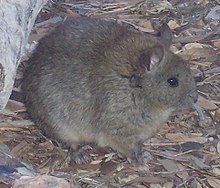Australian bunny rats
| Australian bunny rats | ||||||||||||
|---|---|---|---|---|---|---|---|---|---|---|---|---|

Little bunny rat ( Leporillus apicalis ) according to Gould |
||||||||||||
| Systematics | ||||||||||||
|
||||||||||||
| Scientific name | ||||||||||||
| Leporillus | ||||||||||||
| Thomas , 1906 |

The Australian bunny rats ( Leporillus ) are a genus of Old World mice . They are one of the few placenta animals native to Australia . These include two species, the large bunny rat ( Leporillus conditor ) and the small bunny rat ( Leporillus apicalis ). The latter may have already become extinct, with the great bunny rat only surviving on a few islands.
Features and way of life
Despite their name, bunny rats have little in common with rabbits . The relatively large ears give it its name. In shape and size, however, they rather resemble common rats ( Rattus ). The head body length is 14 to 20 centimeters. The tail of the large bunny rat is slightly shorter than the body, but it becomes up to 25 centimeters long in the small bunny rat. The soft fur is gray-brown to yellow-brown on top; the underside of the big bunny-rat is gray, and the little bunny-rat is white.
In English these animals are called housebuilding rats or stick-nest rats . These names refer to the most noticeable behavioral trait, the building of very large nests from twigs. The habitat of the bunny rats is barren bushland and semi-desert with bushes. Here they are nocturnal and spend the hot days in their nests. The structure of these nests is extremely different. While sometimes only twigs are piled up in a pile, other individuals build elaborate structures that can be up to 1.5 meters high. Obviously it depends on the landscape, which shape a nest takes.
The nest is usually built around an already existing natural structure, for example a rock or a bush. Branches are piled up and intertwined. The nest is covered, the floor inside the nest is padded with soft plant materials. Whole family groups live together in a nest and are constantly working on improving and expanding it.
While the nest-building of the big bunny-rat is well documented, it is controversial whether the little bunny-rat built nests itself or merely used the abandoned dwellings of its larger relatives.
Danger
The bunny rats were once widespread in southern and western Australia. Bone finds from the last centuries show that they still lived in historical times in many places where they are now extinct. The reasons for the dramatic decline in the population are due to human influences: the competition from introduced wild rabbits displaced bunny rats from their habitats, ungulates such as sheep and cattle brought in by the settlers destroyed the nests, and predators such as cats and martens also contributed to the extinction. The two species became largely extinct on mainland Australia in the 1920s and 1930s.
It is not known whether the little bunny rat is still alive. The last confirmed sighting was in 1933, there was a reliable report in 1970. Since then, there have been repeated observations of fresh twigs attached to old nests, which could be an indication that the species is still alive in remote areas. The IUCN lists them as " critically endangered ".
A natural population of the great bunny rat survived on the Franklin Islands in the Nuyts Archipelago . There are said to be a few thousand bunny rats there. To protect the populations there from collapses similar to those on the mainland, bunny rats were also released on Reevesby Island in the Spencer Gulf and other small islands, where all cats and other predators were previously killed. The species is on the IUCN as "endangered" ( vulnerable ) out. The Australian Ministry of the Environment has launched an action plan to save the great bunny rat. The animals are to be released on other islands. Two releases on the mainland (1991/92) failed because the animals fell victim to foxes in a very short time .
Systematics
The bunny rats are systematically part of the Pseudomys group , a predominantly Australian radiation of Old World mice. They are only distantly related to the real rats ( Rattus ).
literature
- Ronald M. Nowak: Walker's Mammals of the World. 2 volumes. 6th edition. Johns Hopkins University Press, Baltimore MD et al. 1999, ISBN 0-8018-5789-9 .
- Don E. Wilson , DeeAnn M. Reeder (Eds.): Mammal Species of the World. A taxonomic and geographic Reference. 2 volumes. 3. Edition. Johns Hopkins University Press, Baltimore MD 2005, ISBN 0-8018-8221-4 .
Web links
- Leporillus on the IUCN Red List of Threatened Species. Retrieved October 9, 2009.
- Drawing of the Big Bunny Rat, Victoria Museum
- Drawing of the Little Bunny Rat, Victoria Museum
- The Recovery of the Greater Stick-nest Council: Page on efforts to save the Great Bunny Rat, with photos
- The Action Plan for Australian Rodents